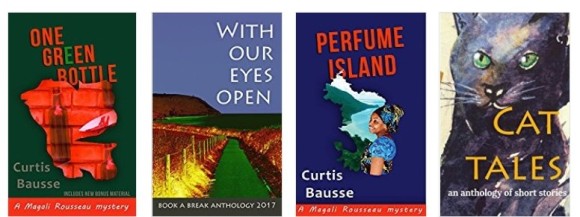
As many of you know, our March Word Weaver Writing Contest has a theme of MYSTERY.
Technically it’s “murder, mystery, suspense.”
Also, I’ve been asked to join a collection of bestselling mystery writers to pen a mystery for an anthology that will come out later this year.
COINCIDENCE???
Pfft. Come on.
So I thought I should explain what makes a good mystery. What’s expected? What’s not?
What do mystery reader fans EXPECT from a really great mystery?
Beats me.

So I asked Curtis Bausse, who writes them.
(I asked Lucy Brazier of the kinda mysterious PorterGirl series about it, too, but since she just did a guest blog post two weeks ago, I figured I’d let Curtis handle this one for us.)
And HE came up with this!
That Curtis is all right, let me tell you. He’s an amazing writer. His stuff has appeared in our Scary Anthology The Box Under The Bed, but that’s because he changed gears and went there. Usually he’s doing the cloak and dagger thing and writing mysteries. If mysteries have cloaks and daggers. Otherwise, forget that.
I should probably defer to him now and stop any further silliness.

DAN: So, Curtis: what is expected of a MYSTERY NOVEL in today’s market?
CURTIS BAUSSE: Well, I managed to gather my thoughts together in one room to see what they had to offer. Bit of a motley bunch but here goes.
The tropes for mysteries are fairly established now, though that doesn’t mean they can’t or won’t evolve.
They’re pretty closely connected to whatever subgenre the writer is going for.
I see two broad categories, depending on the main character:
- police procedural or
- private investigator.
Both of those could be more or less hard-boiled, depending on the amount of gruesomeness the writer puts in.
The PI category splits into
- professional or
- amateur sleuth, who may work with the police or not.
Within that, especially with the amateur sleuth, many go for cosy (Gang, that’s “cozy” in American – Dan) mysteries, with little explicit gore or violence, and sometimes based around a particular theme like cooking (so recipes are given) or handicrafts.
Those are the current approaches
very broadly drawn, and lines can obviously be blurred.
There are character tropes and situations, veering into clichés:
- depressed cop,
- corrupt cop,
- feisty female
- etc.
I’m not sure readers actually expect these but
it’s true that a familiar context allows them to get into the story more easily – they know where they are from the outset.
But readers are also sophisticated and anything that smacks of cliché will turn them off, unless the story itself is gripping or the writing riveting.
There’s room for humour
in all but the most hard-boiled, and readers certainly love that, when it’s done nicely.
The main genres and tropes have all been parodied, so that’s a special humour that can be great, though not easy to pull off. And much as the tropes are established, distorting or upsetting them can work well with readers who like that originality. It’s a fine line to tread between convention and originality, but the best stories are those that manage to achieve it.
An element of the classic whodunit remains at the core of mystery
and though readers have gone beyond that, they still love to be surprised at the end when the detective solves it – though of course, the clues that allow the solution must also be available to the reader along the way, even if given minor importance or mixed in with red herrings.
Sometimes the ‘who’ can be made clear early on
and the story is then about how the solution is reached.
In that case, the reader knows more than the detective – and the writer’s task is to handle that dramatic irony successfully. That sort of treatment is more a staple of the thriller – we see the baddie all along, getting ready to carve up the next victim, and in parallel we see the detective trying to get there before it’s too late.
So there are many ways of treating mystery, not to mention all the possibilities that open up if the meaning of the word is extended to include “mysterious.” Something to consider, but you might not want to take it that far.
Hope this helps. I haven’t read many mystery short stories, so it’s based more on novels, but I don’t see why it shouldn’t apply to short stories, too.
All the best,
Curtis.
Thanks, Curtis! Great job!
Gang, now I know what to do for the book I’m supposed to be writing – and you know some elements for the stories you’re supposed to be writing for the contest!

18 replies on “What Makes A Good Mystery?”
I like dark humour and why is just as interesting as who.
LikeLiked by 2 people
Fair enough.
LikeLiked by 1 person
Good point about the ‘why’ – I didn’t go into motives, which could be a whole new post, but they’re obviously key to the plot. I don’t think there are that many basic motives, whether in real life or fiction – revenge, jealousy, greed are the most common. But the details of the motive – the ‘why’ behind the ‘why’ – can be infinitely varied.
LikeLiked by 2 people
Any time you wanna elaborate in a follow up post, we’re here!
LikeLiked by 1 person
Yes that is food for thought – even in real life criminals turn out to have base motives that make you wonder why they risked and lost everything for riches or revenge.
LikeLiked by 2 people
I agree
LikeLiked by 1 person
Does the story for the contest have to be a mystery, or can the excerpt be based on suspense? Just asking because that’s what I sent you.
LikeLiked by 1 person
For the contest we are pretty loose. You’re fine.
LikeLiked by 1 person
Keep inserting twists. That is what I find works for me. Or greater conflict when the hero thinks that they have reached a conclusion obstruct them.
LikeLiked by 2 people
Yeah. I watched Serpico the other day. The tension kept building and building. Greater conflict. More stress. It was exhausting to watch.
Personally I love writing twists into the story. I sit there and say, okay, NOW what won’t the readers expect? Oh, what if…
LikeLiked by 1 person
Right. False starts, erroneous assumptions, red herrings – all done to set up, and then upset, expectations. Judicious use of twists keeps the reader fully engaged.
LikeLiked by 1 person
That’s gonna be tough to do…
LikeLiked by 1 person
A fantastic post with lots of hints, tips and great advice.
LikeLiked by 3 people
I agree. Curtis is such a big help to me, and he’s helpful so often!
We are very lucky to have his input here.
LikeLiked by 2 people
Aw, Dan, that’s so nice! *blushes* Thanks for asking me for the input – glad to help.
LikeLiked by 1 person
You are very welcome!
LikeLiked by 1 person
Thanks, Adele Marie. Glad it helped!
LikeLiked by 2 people
🙂
LikeLiked by 1 person